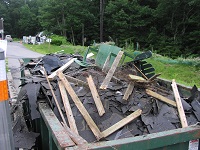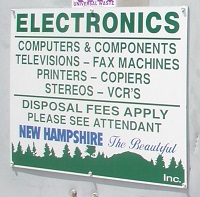Permitted Facilities
Ensuring proper management of solid waste and the facilities that collect, process and dispose of solid waste.
Your facility has obtained a permit from NHDES that outlines terms and conditions for maintaining compliance with RSA 149-M and the Solid Waste Rules (Env-Sw 100 - Env-Sw 2100). In those rules, you must actively manage the solid waste at your facility and do so in such a manner that it does not negatively impact public health or the environment. NHDES does not directly dictate how each facility is to manage the waste streams, however, NHDES maintains compliance standards and provides information to facilities on managing waste streams in a manner that will protect public health and the environment.
BMPs
This manual is intended for use by solid waste operators and municipal officials to promote the implementation of best management practices for solid waste.
Self-Inspection Checklists
Self-inspections are required by rule for solid waste facilities and are an excellent opportunity to evaluate operations and ensure waste materials management is in compliance.
Guidance for Managing Waste Streams at Permitted Facilities
Some waste streams, due to the magnitude in which they are generated and/or the environmental threat they pose, warrant special consideration for management and disposal. Additional information for these waste streams and available resources are provided below.
Construction and Demolition (C&D) Debris
 “Construction and demolition debris,” or “C&D debris,” is defined as waste building materials and rubble which is solid waste generated during the construction, remodeling, repair, or demolition of structures or roads. This includes, but is not limited to, wood, dry wall, asphalt pavement, bricks, concrete and masonry materials. C&D debris DOES NOT INCLUDE the following items: asbestos waste, household trash, corrugated container board, furniture, appliances, tires, drums and containers, fuel tanks, and electrical fixtures containing hazardous liquids (for example, fluorescent light ballasts, transformers).
“Construction and demolition debris,” or “C&D debris,” is defined as waste building materials and rubble which is solid waste generated during the construction, remodeling, repair, or demolition of structures or roads. This includes, but is not limited to, wood, dry wall, asphalt pavement, bricks, concrete and masonry materials. C&D debris DOES NOT INCLUDE the following items: asbestos waste, household trash, corrugated container board, furniture, appliances, tires, drums and containers, fuel tanks, and electrical fixtures containing hazardous liquids (for example, fluorescent light ballasts, transformers).
C&D debris may contain materials that are harmful to human health and the environment. For example, asbestos, lead-based paint, polychlorinated biphenyls (PCBs), and chemicals found in wood treatment products and glues can be present in C&D.
Various materials in the C&D waste stream can be separated for reuse and recycling. For example, concrete, brick and other inert masonry waste can be processed and used as general fill or other construction material. Wood material can be separated and processed by permitted facilities to produce wood chips used to manufacture chip board or other recycled wood products. Wood chips can also be used as fuel in states that allow it to be burned. Read more in the Best Management Practices for NH Solid Waste Facilities: Construction and Demolition Debris.
Electronic Waste
 Electronic waste (e-waste) includes computer towers and monitors, televisions, cell phones, office electronic equipment, DVD players and VCRs. Many of these items contain hazardous materials that can be released into the air and groundwater when they are disposed of in an incinerator or landfill. For this reason, New Hampshire has banned the disposal of video display devices, computer towers and non-mobile video display devices (such as large TVs) in New Hampshire landfills or incinerators. For these banned items, the only options are reuse and recycling. E-waste not specifically identified in the ban should also be recycled instead of landfilled. Read the Best Management Practices for NH Solid Waste Facilities: Electronic Waste.
Electronic waste (e-waste) includes computer towers and monitors, televisions, cell phones, office electronic equipment, DVD players and VCRs. Many of these items contain hazardous materials that can be released into the air and groundwater when they are disposed of in an incinerator or landfill. For this reason, New Hampshire has banned the disposal of video display devices, computer towers and non-mobile video display devices (such as large TVs) in New Hampshire landfills or incinerators. For these banned items, the only options are reuse and recycling. E-waste not specifically identified in the ban should also be recycled instead of landfilled. Read the Best Management Practices for NH Solid Waste Facilities: Electronic Waste.
Infectious Waste & Household Generated Sharps
In New Hampshire, infectious waste is defined as any waste that, because of its infectious nature, may cause or significantly contribute to an increase in mortality or an increase in serious irreversible or incapacitating reversible illness, or pose a substantial present or potential hazard to human health or the environment when improperly treated, stored, transported, disposed of or otherwise managed. Infectious waste can be generated at many different facilities, including doctors’ and dentists’ offices, hospitals, clinics, schools, nursing homes, mortuaries and veterinary facilities. Read more about management of household sharps.
Stumps and Brush
Stumps and brush are generated as a result of most types of development. In New Hampshire, the management of discarded stumps and brush is regulated as a solid waste activity under the provisions of the New Hampshire Solid Waste Rules. Read more about stumps and brush.




